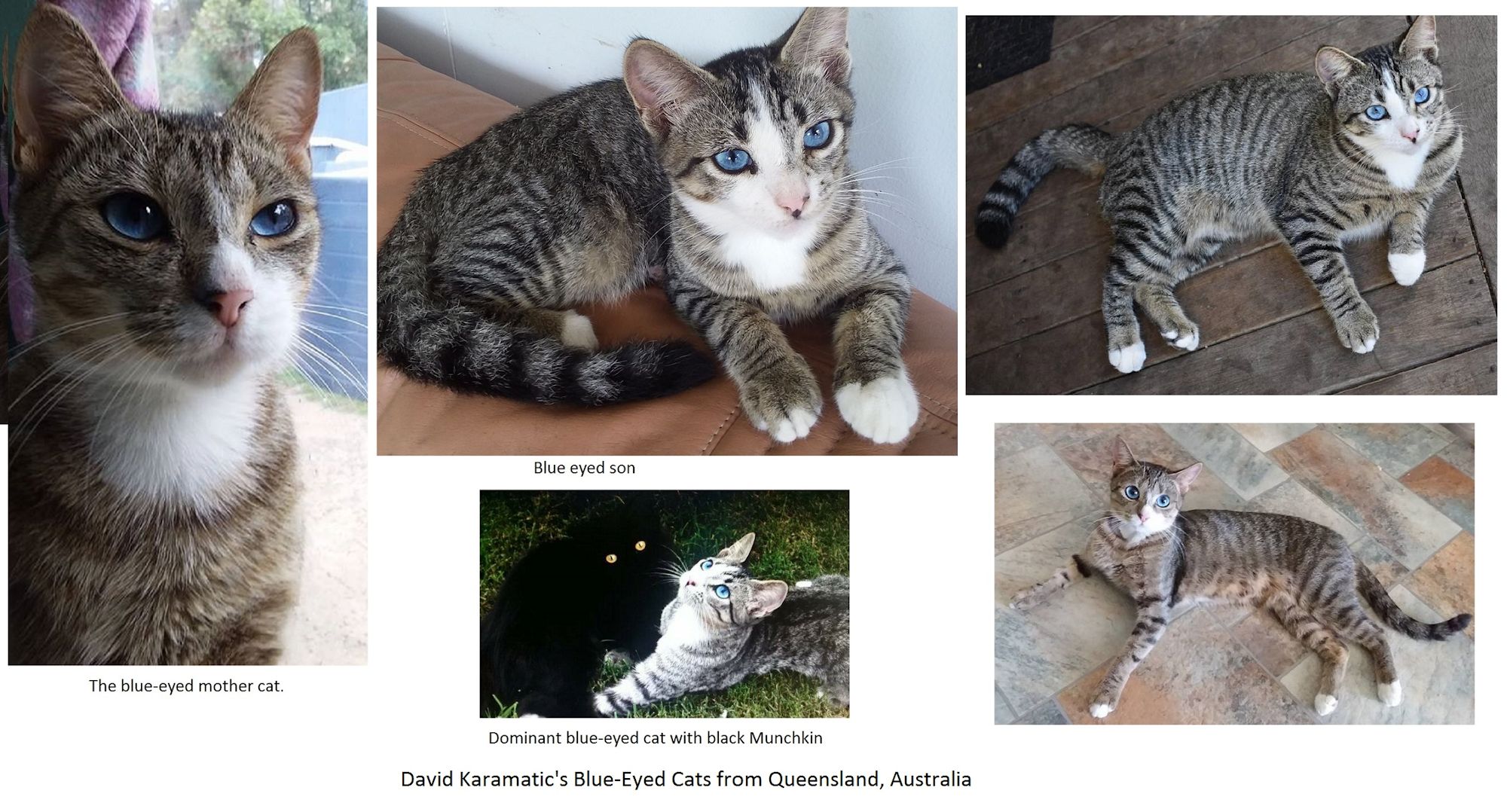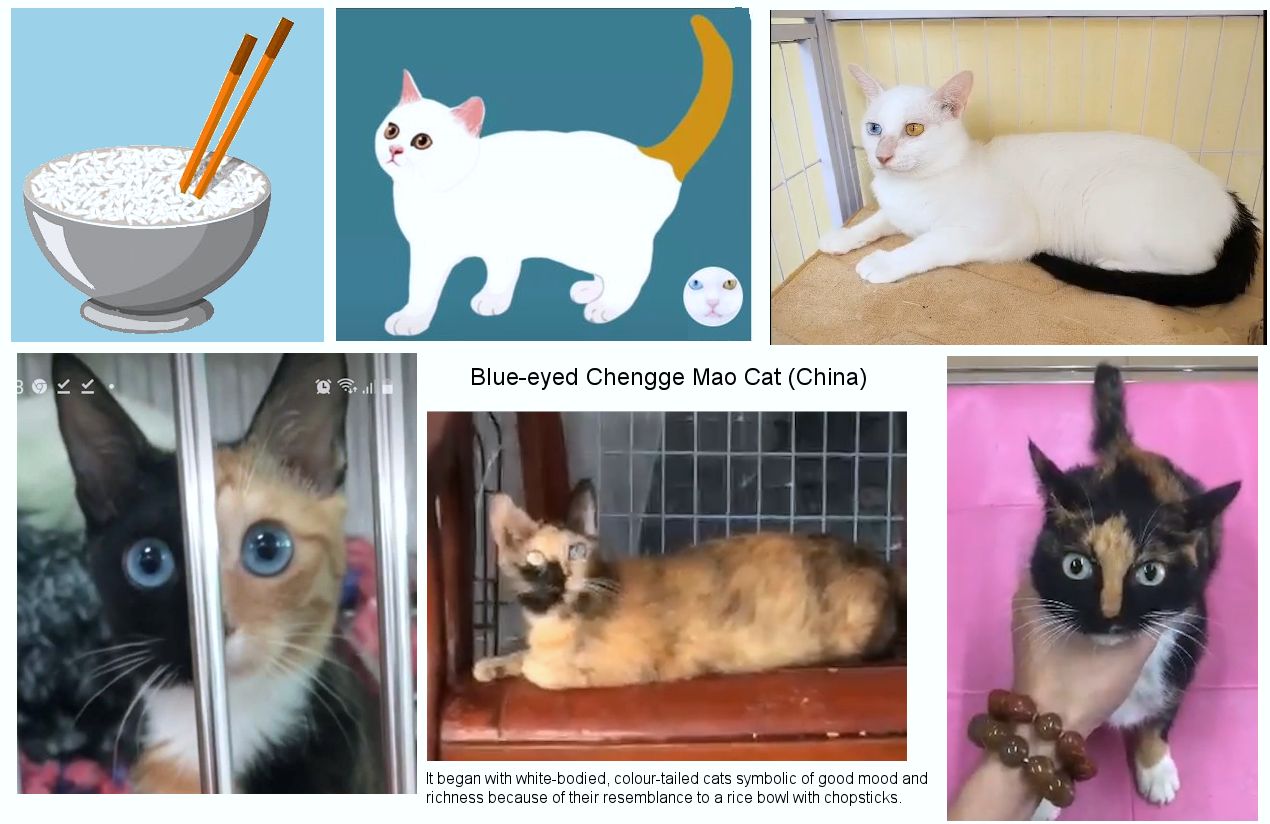
BLUE-EYED BREEDS - AUSTRALIAN MUTATION, CHINESE MUTATION, BLUE-EYED BURMILLAS, BURMESE AND TONKINESE (NATURALLY OCCURRING)
AUSTRALIAN DOMINANT BLUE-EYE MUTATION
David Karamatic is working with a dominant blue eyed mutation discovered in tropical north Queensland, Australia. He was notified of some "free to good home" kittens that had retained their blue eyes. There were four in the litter three with blue eyes and one odd eyed. At first he thought it was the influence of white-spotting, but the odd eyed kitten was nearly completely black. He obtained the last kitten available, and at seven months old its eye colour is very deep and vivid almost violet. It would be interesting to see if this gene is the same as the Celestial / Topaz or perhaps on the same locus. David first wants to find out if the mutation is the same as his imported French Celestial (Maidee, from Chatterie d'Aerlin), and he is also submitting samples for DNA tests.

CHENGGE MAO CATS, CHINESE DOMINANT BLUE-EYE MUTATIONS
In November 2020, Rano Makarenko sent me information about some Chinese cats known as Chengge mao. The variety lives in Chengge and the breeder selects them for mouse-catching and is not at all interested in genetics questions. Originally, the Chengge mao was white with a coloured tail, symbolic of good mood and richness because of a resemblance to a rice bowl with chopsticks (Van pattern without head markings). Then the cats started producing blue eyed cats from the white cats with coloured tails.

Blue-eyed solid colour cats (often red-colour cats) are known to be bred and sold in part of China, but there is no control over the breeding and the gene(s) involved are unidentified. One breeder reported a hgh mortality rate with 50% of kittens from his blue-eyed red ticked female mated to a blue-eyed red classic tabby male being solid white and stillborn/dying at birth. Though there could be various reasons for this, there is a possibility of 2 incompatible blue-eye genes being bred together. Breeding the blue-eyed red-ticked female to an unrelated normal-eyed cat and then breeding a male offspring back to the red-ticked female would produce kittens with only one blue eyed mutation (and could also show if the stillbirths were due to a reproductive issue with the female herself.)

BLUE-EYED BURMILLAS, BURMESE AND TONKINESE
Blue eyed kittens sometimes occur in Burmilla (derived from Burmese x Chinchilla ancestors) lines with browns and chocolates in the pedigree. Although they don't match the breed standard (green eyes), they were usually the first kittens to be sold. The blue eyes likely trace to a Himalayan ancestor many generations ago. DNA tests have identified the colourpoint (Siamese) gene in some Burmillas. In the 1980s, Himalayans/Colourpoint Persians and Chinchillas were crossed to produce the lynx and smoke point series Himalayans/Colourpoint Persians. Genetically chocolate cats (and chocolate carriers) were used in the breeding programmes and some Chocolate Chinchillas/Goldens were registered without stating they were chocolate. Aquamarine eyes have also been seen in Burmillas, where the Burmese sepia gene meets up with the colourpoint gene. Because many breeders breed for light coat colour without markings, aquamarine eyes (linked to mink colour) are less important than clear silver. This also means that Burmillas have become lighter in colour than the original British cats. DNA testing on some Burmilla lines also identified the white gloving gene is present although it is not visibly expressed.
There is a line of blue-eyed Tonkinese from Joan Bernstein who bred some blue eyed sepia variants. Descendants of her cats continue to produce blue eyed sepias and blue-eyed minks.